BSc Business Management BMP4005: Big Data Analysis Report
VerifiedAdded on 2023/06/17
|8
|2117
|263
Report
AI Summary
This report provides an overview of big data, its characteristics, and the challenges associated with its analysis. It discusses various techniques available for analyzing big data, such as data mining, data integration, and A/B testing. The report also highlights how big data technology can support business by fostering decision-making, improving customer insights, and enabling automation. The report concludes that big data plays a crucial role in the development of both organizations and the country, emphasizing the importance of understanding the information for strategic decision-making and market monitoring. It includes a digital poster and references.
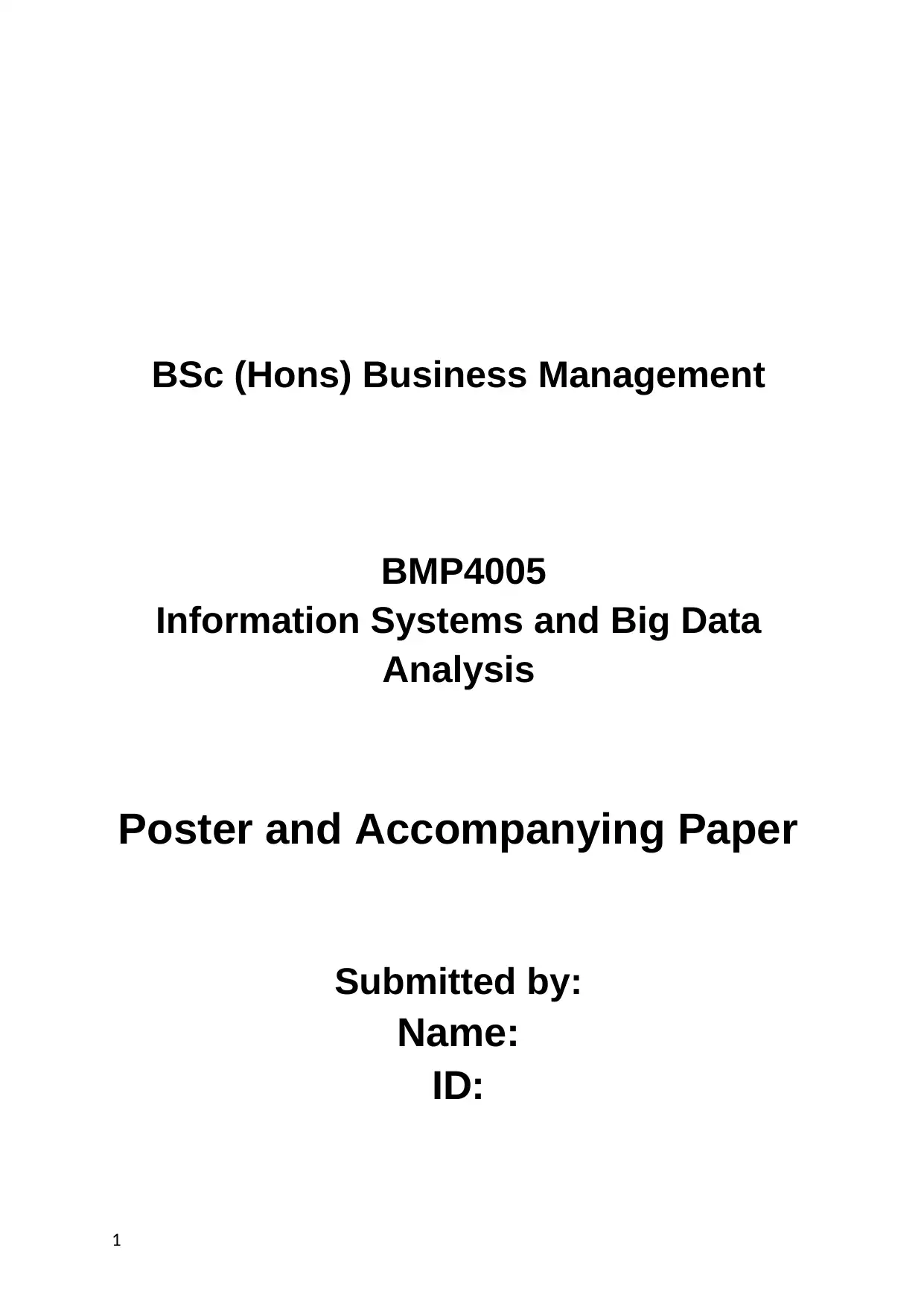
BSc (Hons) Business Management
BMP4005
Information Systems and Big Data
Analysis
Poster and Accompanying Paper
Submitted by:
Name:
ID:
1
BMP4005
Information Systems and Big Data
Analysis
Poster and Accompanying Paper
Submitted by:
Name:
ID:
1
Paraphrase This Document
Need a fresh take? Get an instant paraphrase of this document with our AI Paraphraser
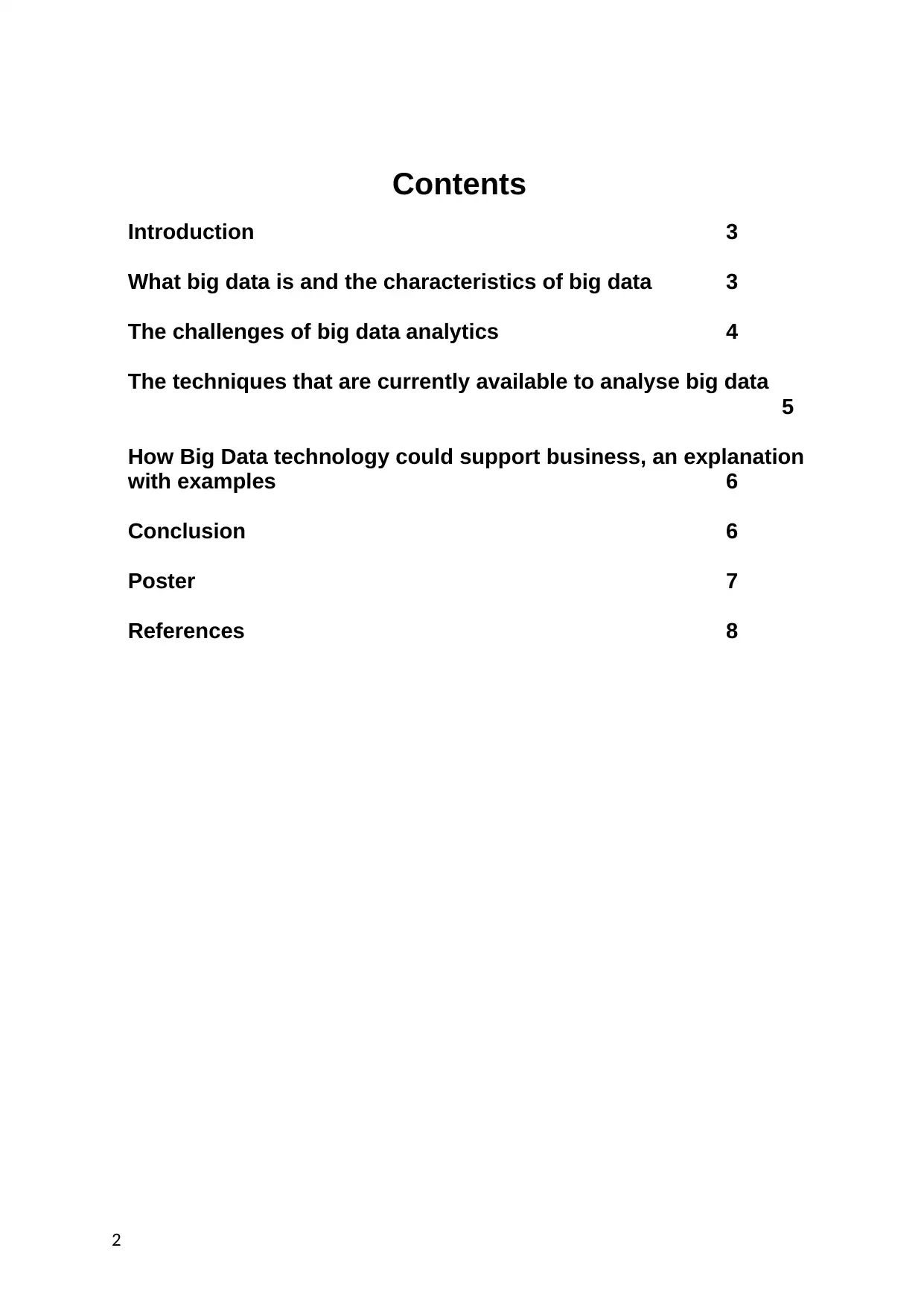
Contents
Introduction 3
What big data is and the characteristics of big data 3
The challenges of big data analytics 4
The techniques that are currently available to analyse big data
5
How Big Data technology could support business, an explanation
with examples 6
Conclusion 6
Poster 7
References 8
2
Introduction 3
What big data is and the characteristics of big data 3
The challenges of big data analytics 4
The techniques that are currently available to analyse big data
5
How Big Data technology could support business, an explanation
with examples 6
Conclusion 6
Poster 7
References 8
2
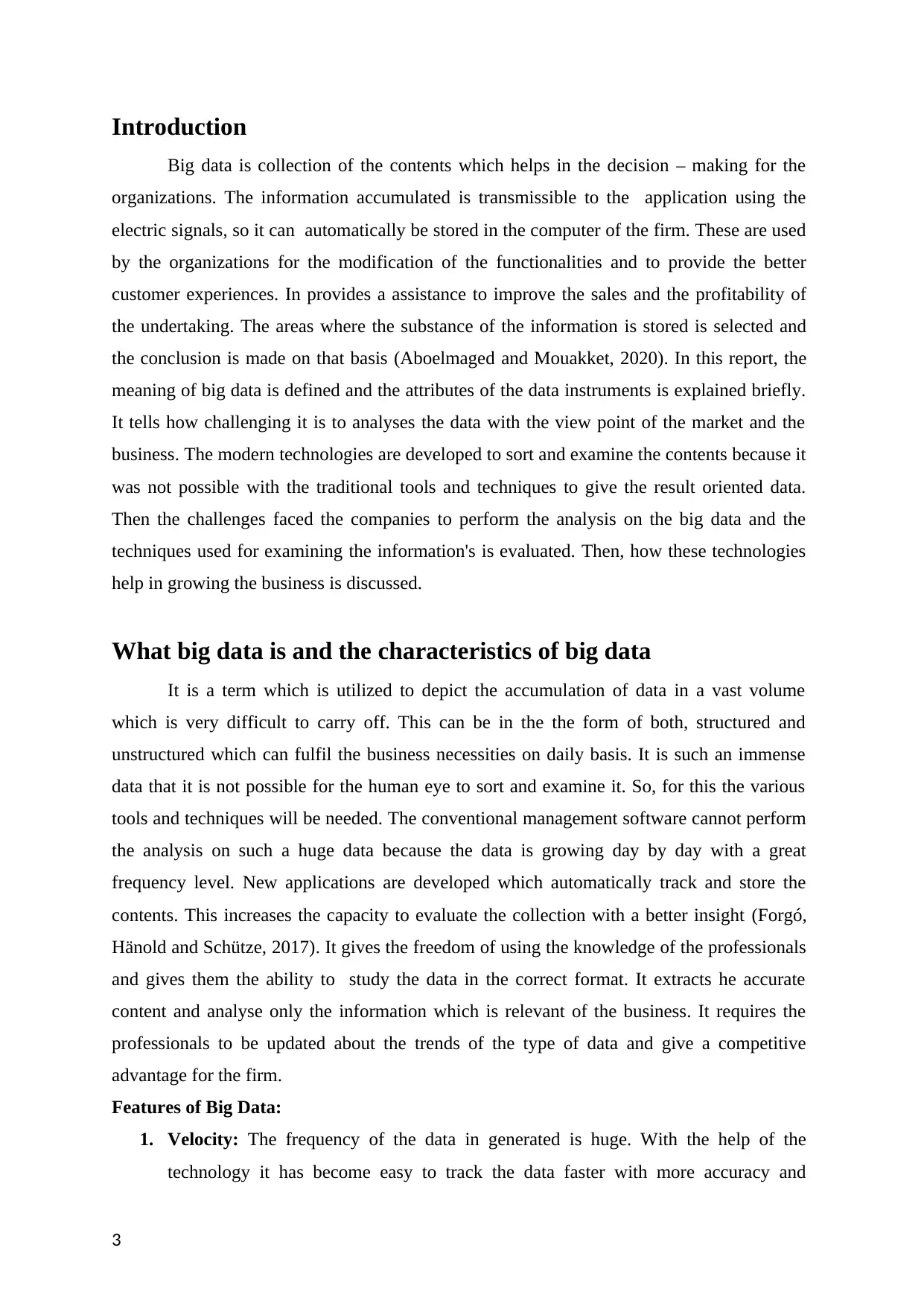
Introduction
Big data is collection of the contents which helps in the decision – making for the
organizations. The information accumulated is transmissible to the application using the
electric signals, so it can automatically be stored in the computer of the firm. These are used
by the organizations for the modification of the functionalities and to provide the better
customer experiences. In provides a assistance to improve the sales and the profitability of
the undertaking. The areas where the substance of the information is stored is selected and
the conclusion is made on that basis (Aboelmaged and Mouakket, 2020). In this report, the
meaning of big data is defined and the attributes of the data instruments is explained briefly.
It tells how challenging it is to analyses the data with the view point of the market and the
business. The modern technologies are developed to sort and examine the contents because it
was not possible with the traditional tools and techniques to give the result oriented data.
Then the challenges faced the companies to perform the analysis on the big data and the
techniques used for examining the information's is evaluated. Then, how these technologies
help in growing the business is discussed.
What big data is and the characteristics of big data
It is a term which is utilized to depict the accumulation of data in a vast volume
which is very difficult to carry off. This can be in the the form of both, structured and
unstructured which can fulfil the business necessities on daily basis. It is such an immense
data that it is not possible for the human eye to sort and examine it. So, for this the various
tools and techniques will be needed. The conventional management software cannot perform
the analysis on such a huge data because the data is growing day by day with a great
frequency level. New applications are developed which automatically track and store the
contents. This increases the capacity to evaluate the collection with a better insight (Forgó,
Hänold and Schütze, 2017). It gives the freedom of using the knowledge of the professionals
and gives them the ability to study the data in the correct format. It extracts he accurate
content and analyse only the information which is relevant of the business. It requires the
professionals to be updated about the trends of the type of data and give a competitive
advantage for the firm.
Features of Big Data:
1. Velocity: The frequency of the data in generated is huge. With the help of the
technology it has become easy to track the data faster with more accuracy and
3
Big data is collection of the contents which helps in the decision – making for the
organizations. The information accumulated is transmissible to the application using the
electric signals, so it can automatically be stored in the computer of the firm. These are used
by the organizations for the modification of the functionalities and to provide the better
customer experiences. In provides a assistance to improve the sales and the profitability of
the undertaking. The areas where the substance of the information is stored is selected and
the conclusion is made on that basis (Aboelmaged and Mouakket, 2020). In this report, the
meaning of big data is defined and the attributes of the data instruments is explained briefly.
It tells how challenging it is to analyses the data with the view point of the market and the
business. The modern technologies are developed to sort and examine the contents because it
was not possible with the traditional tools and techniques to give the result oriented data.
Then the challenges faced the companies to perform the analysis on the big data and the
techniques used for examining the information's is evaluated. Then, how these technologies
help in growing the business is discussed.
What big data is and the characteristics of big data
It is a term which is utilized to depict the accumulation of data in a vast volume
which is very difficult to carry off. This can be in the the form of both, structured and
unstructured which can fulfil the business necessities on daily basis. It is such an immense
data that it is not possible for the human eye to sort and examine it. So, for this the various
tools and techniques will be needed. The conventional management software cannot perform
the analysis on such a huge data because the data is growing day by day with a great
frequency level. New applications are developed which automatically track and store the
contents. This increases the capacity to evaluate the collection with a better insight (Forgó,
Hänold and Schütze, 2017). It gives the freedom of using the knowledge of the professionals
and gives them the ability to study the data in the correct format. It extracts he accurate
content and analyse only the information which is relevant of the business. It requires the
professionals to be updated about the trends of the type of data and give a competitive
advantage for the firm.
Features of Big Data:
1. Velocity: The frequency of the data in generated is huge. With the help of the
technology it has become easy to track the data faster with more accuracy and
3
⊘ This is a preview!⊘
Do you want full access?
Subscribe today to unlock all pages.

Trusted by 1+ million students worldwide
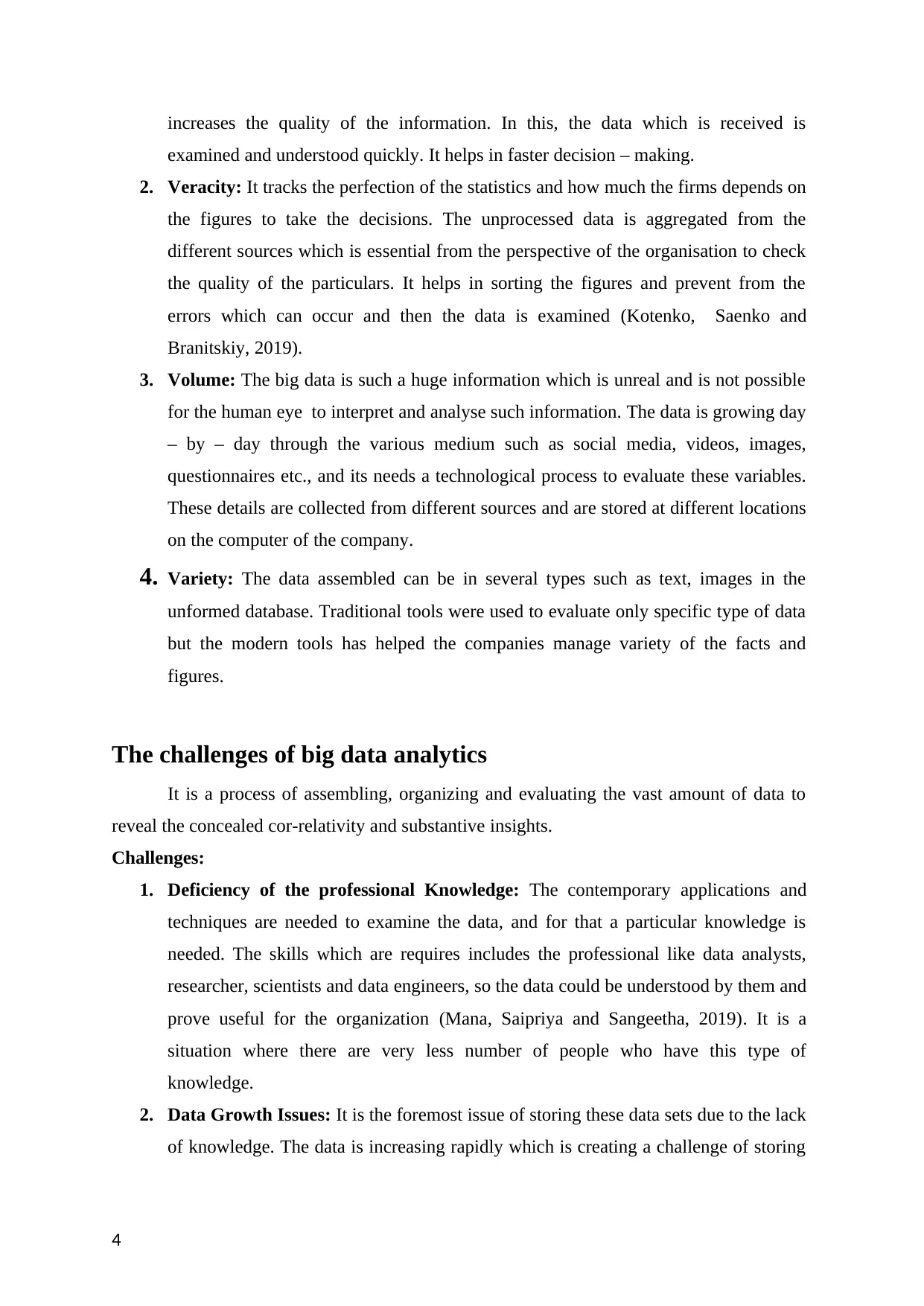
increases the quality of the information. In this, the data which is received is
examined and understood quickly. It helps in faster decision – making.
2. Veracity: It tracks the perfection of the statistics and how much the firms depends on
the figures to take the decisions. The unprocessed data is aggregated from the
different sources which is essential from the perspective of the organisation to check
the quality of the particulars. It helps in sorting the figures and prevent from the
errors which can occur and then the data is examined (Kotenko, Saenko and
Branitskiy, 2019).
3. Volume: The big data is such a huge information which is unreal and is not possible
for the human eye to interpret and analyse such information. The data is growing day
– by – day through the various medium such as social media, videos, images,
questionnaires etc., and its needs a technological process to evaluate these variables.
These details are collected from different sources and are stored at different locations
on the computer of the company.
4. Variety: The data assembled can be in several types such as text, images in the
unformed database. Traditional tools were used to evaluate only specific type of data
but the modern tools has helped the companies manage variety of the facts and
figures.
The challenges of big data analytics
It is a process of assembling, organizing and evaluating the vast amount of data to
reveal the concealed cor-relativity and substantive insights.
Challenges:
1. Deficiency of the professional Knowledge: The contemporary applications and
techniques are needed to examine the data, and for that a particular knowledge is
needed. The skills which are requires includes the professional like data analysts,
researcher, scientists and data engineers, so the data could be understood by them and
prove useful for the organization (Mana, Saipriya and Sangeetha, 2019). It is a
situation where there are very less number of people who have this type of
knowledge.
2. Data Growth Issues: It is the foremost issue of storing these data sets due to the lack
of knowledge. The data is increasing rapidly which is creating a challenge of storing
4
examined and understood quickly. It helps in faster decision – making.
2. Veracity: It tracks the perfection of the statistics and how much the firms depends on
the figures to take the decisions. The unprocessed data is aggregated from the
different sources which is essential from the perspective of the organisation to check
the quality of the particulars. It helps in sorting the figures and prevent from the
errors which can occur and then the data is examined (Kotenko, Saenko and
Branitskiy, 2019).
3. Volume: The big data is such a huge information which is unreal and is not possible
for the human eye to interpret and analyse such information. The data is growing day
– by – day through the various medium such as social media, videos, images,
questionnaires etc., and its needs a technological process to evaluate these variables.
These details are collected from different sources and are stored at different locations
on the computer of the company.
4. Variety: The data assembled can be in several types such as text, images in the
unformed database. Traditional tools were used to evaluate only specific type of data
but the modern tools has helped the companies manage variety of the facts and
figures.
The challenges of big data analytics
It is a process of assembling, organizing and evaluating the vast amount of data to
reveal the concealed cor-relativity and substantive insights.
Challenges:
1. Deficiency of the professional Knowledge: The contemporary applications and
techniques are needed to examine the data, and for that a particular knowledge is
needed. The skills which are requires includes the professional like data analysts,
researcher, scientists and data engineers, so the data could be understood by them and
prove useful for the organization (Mana, Saipriya and Sangeetha, 2019). It is a
situation where there are very less number of people who have this type of
knowledge.
2. Data Growth Issues: It is the foremost issue of storing these data sets due to the lack
of knowledge. The data is increasing rapidly which is creating a challenge of storing
4
Paraphrase This Document
Need a fresh take? Get an instant paraphrase of this document with our AI Paraphraser
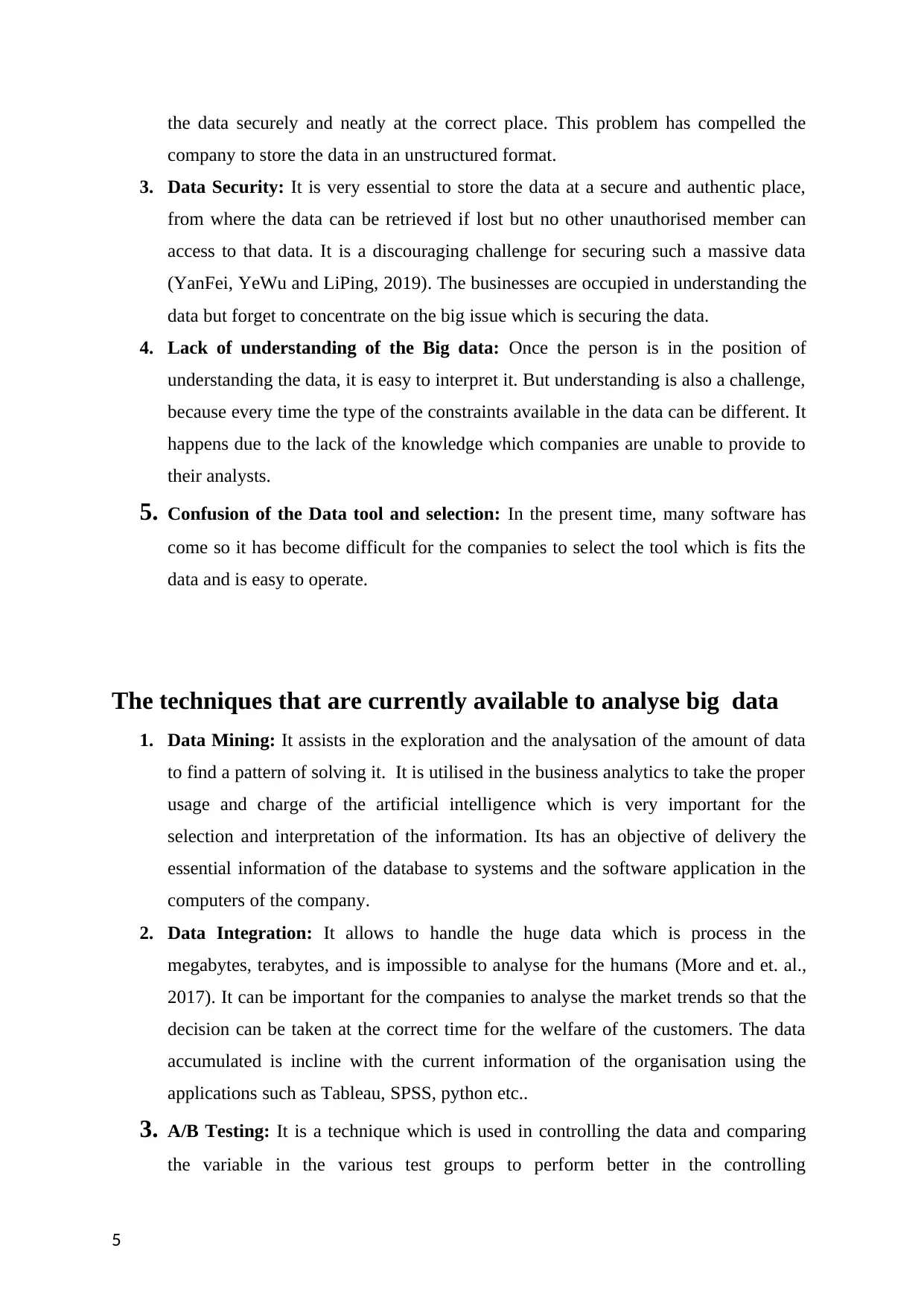
the data securely and neatly at the correct place. This problem has compelled the
company to store the data in an unstructured format.
3. Data Security: It is very essential to store the data at a secure and authentic place,
from where the data can be retrieved if lost but no other unauthorised member can
access to that data. It is a discouraging challenge for securing such a massive data
(YanFei, YeWu and LiPing, 2019). The businesses are occupied in understanding the
data but forget to concentrate on the big issue which is securing the data.
4. Lack of understanding of the Big data: Once the person is in the position of
understanding the data, it is easy to interpret it. But understanding is also a challenge,
because every time the type of the constraints available in the data can be different. It
happens due to the lack of the knowledge which companies are unable to provide to
their analysts.
5. Confusion of the Data tool and selection: In the present time, many software has
come so it has become difficult for the companies to select the tool which is fits the
data and is easy to operate.
The techniques that are currently available to analyse big data
1. Data Mining: It assists in the exploration and the analysation of the amount of data
to find a pattern of solving it. It is utilised in the business analytics to take the proper
usage and charge of the artificial intelligence which is very important for the
selection and interpretation of the information. Its has an objective of delivery the
essential information of the database to systems and the software application in the
computers of the company.
2. Data Integration: It allows to handle the huge data which is process in the
megabytes, terabytes, and is impossible to analyse for the humans (More and et. al.,
2017). It can be important for the companies to analyse the market trends so that the
decision can be taken at the correct time for the welfare of the customers. The data
accumulated is incline with the current information of the organisation using the
applications such as Tableau, SPSS, python etc..
3. A/B Testing: It is a technique which is used in controlling the data and comparing
the variable in the various test groups to perform better in the controlling
5
company to store the data in an unstructured format.
3. Data Security: It is very essential to store the data at a secure and authentic place,
from where the data can be retrieved if lost but no other unauthorised member can
access to that data. It is a discouraging challenge for securing such a massive data
(YanFei, YeWu and LiPing, 2019). The businesses are occupied in understanding the
data but forget to concentrate on the big issue which is securing the data.
4. Lack of understanding of the Big data: Once the person is in the position of
understanding the data, it is easy to interpret it. But understanding is also a challenge,
because every time the type of the constraints available in the data can be different. It
happens due to the lack of the knowledge which companies are unable to provide to
their analysts.
5. Confusion of the Data tool and selection: In the present time, many software has
come so it has become difficult for the companies to select the tool which is fits the
data and is easy to operate.
The techniques that are currently available to analyse big data
1. Data Mining: It assists in the exploration and the analysation of the amount of data
to find a pattern of solving it. It is utilised in the business analytics to take the proper
usage and charge of the artificial intelligence which is very important for the
selection and interpretation of the information. Its has an objective of delivery the
essential information of the database to systems and the software application in the
computers of the company.
2. Data Integration: It allows to handle the huge data which is process in the
megabytes, terabytes, and is impossible to analyse for the humans (More and et. al.,
2017). It can be important for the companies to analyse the market trends so that the
decision can be taken at the correct time for the welfare of the customers. The data
accumulated is incline with the current information of the organisation using the
applications such as Tableau, SPSS, python etc..
3. A/B Testing: It is a technique which is used in controlling the data and comparing
the variable in the various test groups to perform better in the controlling
5
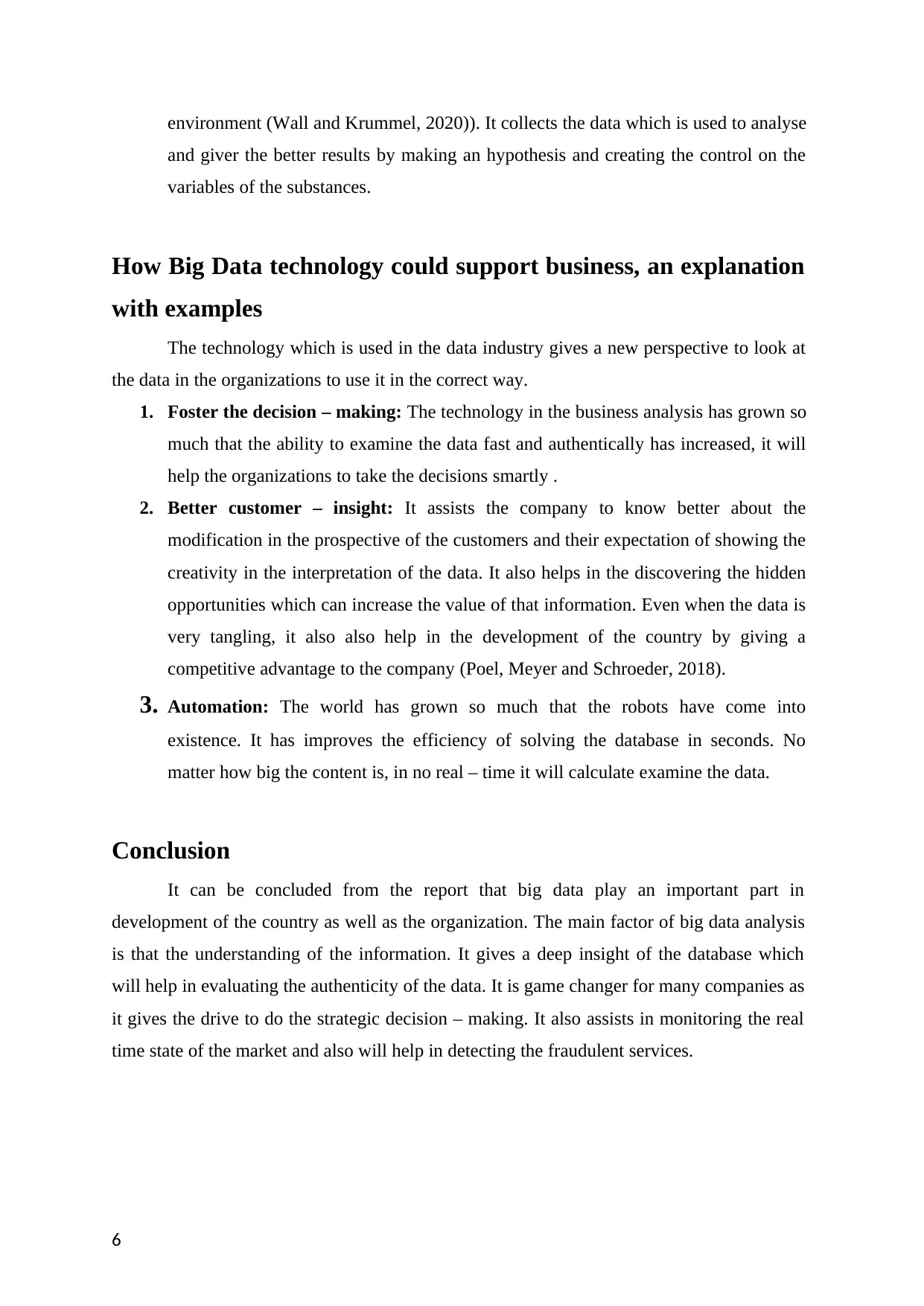
environment (Wall and Krummel, 2020)). It collects the data which is used to analyse
and giver the better results by making an hypothesis and creating the control on the
variables of the substances.
How Big Data technology could support business, an explanation
with examples
The technology which is used in the data industry gives a new perspective to look at
the data in the organizations to use it in the correct way.
1. Foster the decision – making: The technology in the business analysis has grown so
much that the ability to examine the data fast and authentically has increased, it will
help the organizations to take the decisions smartly .
2. Better customer – insight: It assists the company to know better about the
modification in the prospective of the customers and their expectation of showing the
creativity in the interpretation of the data. It also helps in the discovering the hidden
opportunities which can increase the value of that information. Even when the data is
very tangling, it also also help in the development of the country by giving a
competitive advantage to the company (Poel, Meyer and Schroeder, 2018).
3. Automation: The world has grown so much that the robots have come into
existence. It has improves the efficiency of solving the database in seconds. No
matter how big the content is, in no real – time it will calculate examine the data.
Conclusion
It can be concluded from the report that big data play an important part in
development of the country as well as the organization. The main factor of big data analysis
is that the understanding of the information. It gives a deep insight of the database which
will help in evaluating the authenticity of the data. It is game changer for many companies as
it gives the drive to do the strategic decision – making. It also assists in monitoring the real
time state of the market and also will help in detecting the fraudulent services.
6
and giver the better results by making an hypothesis and creating the control on the
variables of the substances.
How Big Data technology could support business, an explanation
with examples
The technology which is used in the data industry gives a new perspective to look at
the data in the organizations to use it in the correct way.
1. Foster the decision – making: The technology in the business analysis has grown so
much that the ability to examine the data fast and authentically has increased, it will
help the organizations to take the decisions smartly .
2. Better customer – insight: It assists the company to know better about the
modification in the prospective of the customers and their expectation of showing the
creativity in the interpretation of the data. It also helps in the discovering the hidden
opportunities which can increase the value of that information. Even when the data is
very tangling, it also also help in the development of the country by giving a
competitive advantage to the company (Poel, Meyer and Schroeder, 2018).
3. Automation: The world has grown so much that the robots have come into
existence. It has improves the efficiency of solving the database in seconds. No
matter how big the content is, in no real – time it will calculate examine the data.
Conclusion
It can be concluded from the report that big data play an important part in
development of the country as well as the organization. The main factor of big data analysis
is that the understanding of the information. It gives a deep insight of the database which
will help in evaluating the authenticity of the data. It is game changer for many companies as
it gives the drive to do the strategic decision – making. It also assists in monitoring the real
time state of the market and also will help in detecting the fraudulent services.
6
⊘ This is a preview!⊘
Do you want full access?
Subscribe today to unlock all pages.

Trusted by 1+ million students worldwide
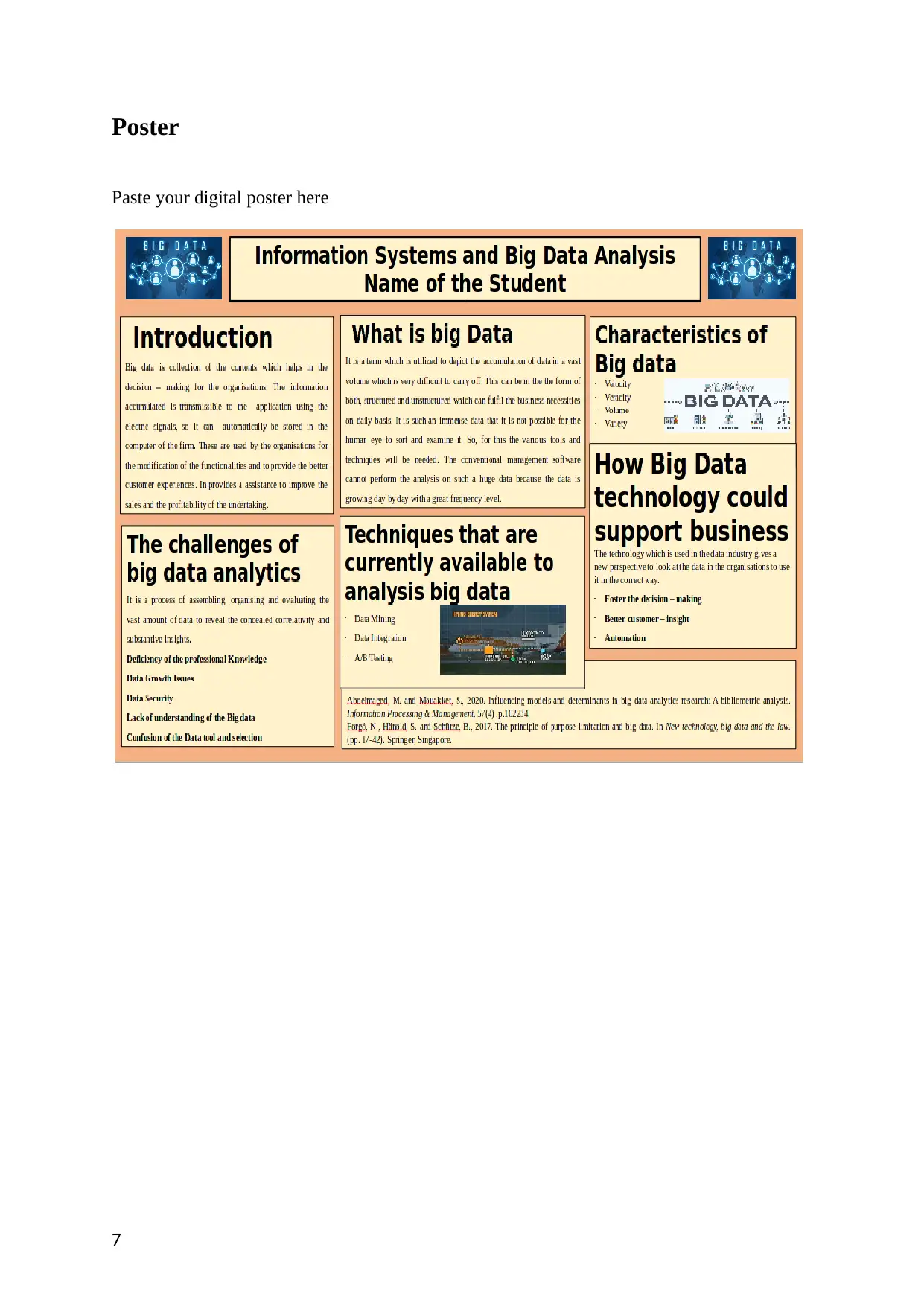
Poster
Paste your digital poster here
7
Paste your digital poster here
7
Paraphrase This Document
Need a fresh take? Get an instant paraphrase of this document with our AI Paraphraser
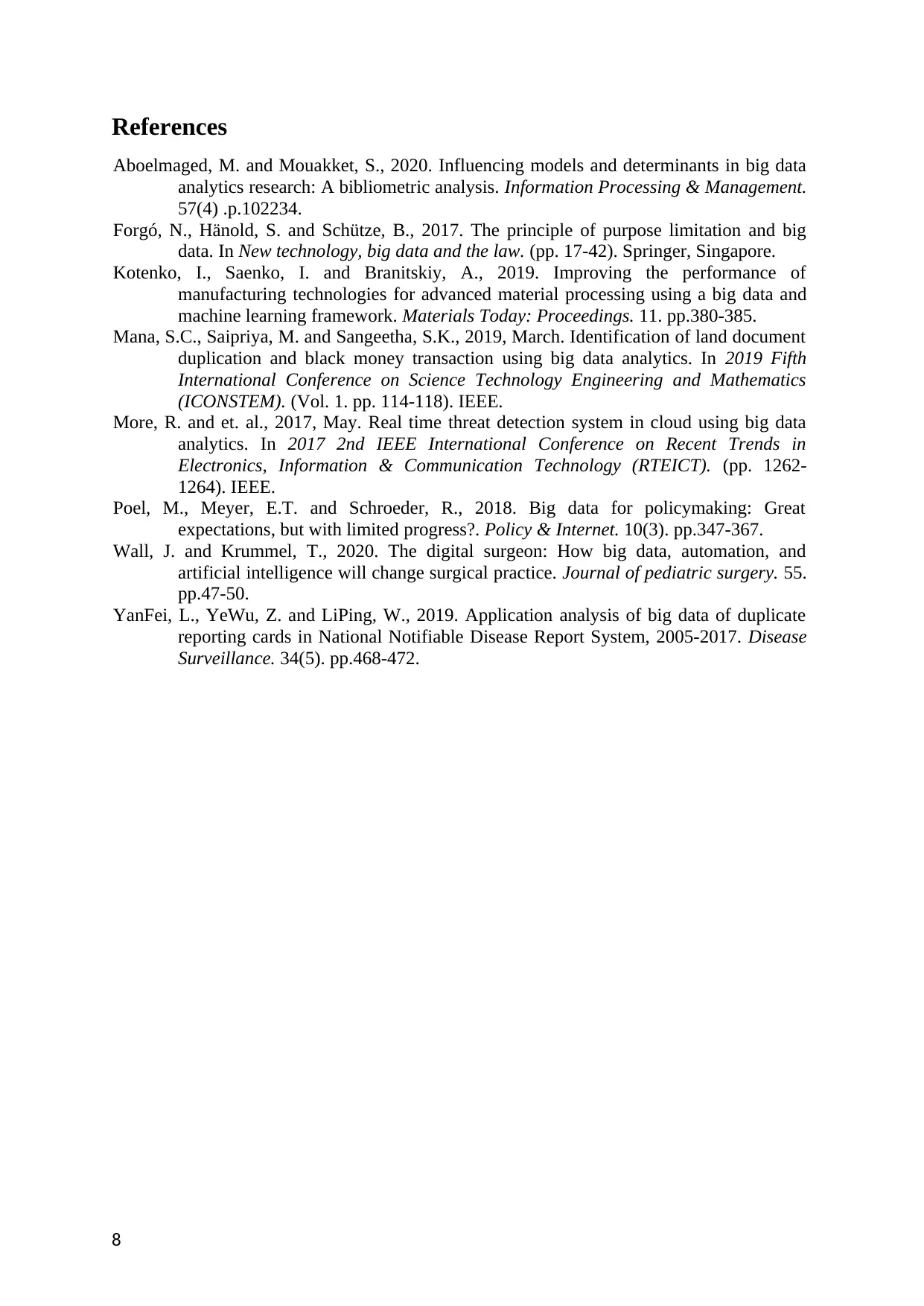
References
Aboelmaged, M. and Mouakket, S., 2020. Influencing models and determinants in big data
analytics research: A bibliometric analysis. Information Processing & Management.
57(4) .p.102234.
Forgó, N., Hänold, S. and Schütze, B., 2017. The principle of purpose limitation and big
data. In New technology, big data and the law. (pp. 17-42). Springer, Singapore.
Kotenko, I., Saenko, I. and Branitskiy, A., 2019. Improving the performance of
manufacturing technologies for advanced material processing using a big data and
machine learning framework. Materials Today: Proceedings. 11. pp.380-385.
Mana, S.C., Saipriya, M. and Sangeetha, S.K., 2019, March. Identification of land document
duplication and black money transaction using big data analytics. In 2019 Fifth
International Conference on Science Technology Engineering and Mathematics
(ICONSTEM). (Vol. 1. pp. 114-118). IEEE.
More, R. and et. al., 2017, May. Real time threat detection system in cloud using big data
analytics. In 2017 2nd IEEE International Conference on Recent Trends in
Electronics, Information & Communication Technology (RTEICT). (pp. 1262-
1264). IEEE.
Poel, M., Meyer, E.T. and Schroeder, R., 2018. Big data for policymaking: Great
expectations, but with limited progress?. Policy & Internet. 10(3). pp.347-367.
Wall, J. and Krummel, T., 2020. The digital surgeon: How big data, automation, and
artificial intelligence will change surgical practice. Journal of pediatric surgery. 55.
pp.47-50.
YanFei, L., YeWu, Z. and LiPing, W., 2019. Application analysis of big data of duplicate
reporting cards in National Notifiable Disease Report System, 2005-2017. Disease
Surveillance. 34(5). pp.468-472.
8
Aboelmaged, M. and Mouakket, S., 2020. Influencing models and determinants in big data
analytics research: A bibliometric analysis. Information Processing & Management.
57(4) .p.102234.
Forgó, N., Hänold, S. and Schütze, B., 2017. The principle of purpose limitation and big
data. In New technology, big data and the law. (pp. 17-42). Springer, Singapore.
Kotenko, I., Saenko, I. and Branitskiy, A., 2019. Improving the performance of
manufacturing technologies for advanced material processing using a big data and
machine learning framework. Materials Today: Proceedings. 11. pp.380-385.
Mana, S.C., Saipriya, M. and Sangeetha, S.K., 2019, March. Identification of land document
duplication and black money transaction using big data analytics. In 2019 Fifth
International Conference on Science Technology Engineering and Mathematics
(ICONSTEM). (Vol. 1. pp. 114-118). IEEE.
More, R. and et. al., 2017, May. Real time threat detection system in cloud using big data
analytics. In 2017 2nd IEEE International Conference on Recent Trends in
Electronics, Information & Communication Technology (RTEICT). (pp. 1262-
1264). IEEE.
Poel, M., Meyer, E.T. and Schroeder, R., 2018. Big data for policymaking: Great
expectations, but with limited progress?. Policy & Internet. 10(3). pp.347-367.
Wall, J. and Krummel, T., 2020. The digital surgeon: How big data, automation, and
artificial intelligence will change surgical practice. Journal of pediatric surgery. 55.
pp.47-50.
YanFei, L., YeWu, Z. and LiPing, W., 2019. Application analysis of big data of duplicate
reporting cards in National Notifiable Disease Report System, 2005-2017. Disease
Surveillance. 34(5). pp.468-472.
8
1 out of 8
Related Documents
Your All-in-One AI-Powered Toolkit for Academic Success.
+13062052269
info@desklib.com
Available 24*7 on WhatsApp / Email
![[object Object]](/_next/static/media/star-bottom.7253800d.svg)
Unlock your academic potential
Copyright © 2020–2025 A2Z Services. All Rights Reserved. Developed and managed by ZUCOL.

